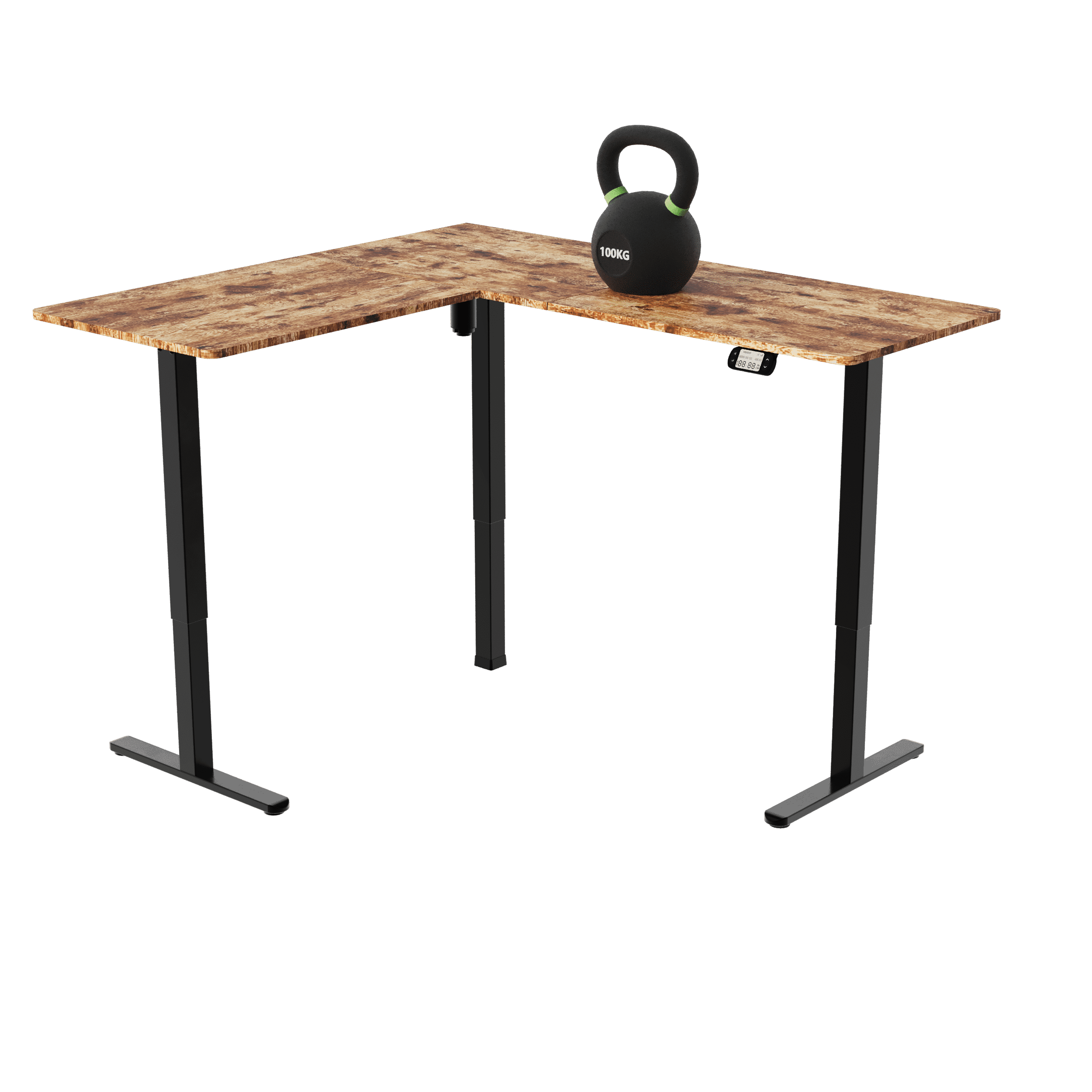Maximizing Productivity with an L-Shaped Standing Desk
The modern workspace demands furniture that adapts to diverse working styles while promoting health and efficiency. An L-shaped standing desk offers the perfect solution, combining ergonomic benefits with smart space utilization. Unlike traditional rectangular desks, the L-shaped standing desk configuration provides distinct work zones while allowing seamless transitions between sitting and standing positions. Professionals across industries are discovering how this innovative furniture piece can transform their work experience, from programmers managing multiple monitors to creative directors reviewing large-format designs. The unique geometry of an L-shaped standing desk creates natural separation between different tasks while maintaining everything within comfortable reach.
Understanding L-Shaped Standing Desk Dimensions
Calculating the Right Size for Your Space
Selecting the proper dimensions for your L-shaped standing desk begins with careful measurement of your available area. Standard configurations typically feature 60-inch sides that form a perfect right angle, though many manufacturers offer customizable lengths for each leg. Corner units require at least 5 feet of clearance in both directions to accommodate chair movement and comfortable access. When measuring, consider not just the floor footprint but also the vertical space needed for full height adjustment - most L-shaped standing desks extend from 29 inches to 48 inches tall. The depth of each desk section (usually 24-30 inches) determines how much equipment you can accommodate while maintaining proper viewing distance from monitors.
Weight Capacity and Structural Considerations
The robust construction of quality L-shaped standing desks ensures stability at all height positions. Look for models with a minimum 200-pound capacity distributed across both surfaces to safely support multiple monitors, computers, and work materials. Dual-motor lift systems provide the smoothest operation and most even weight distribution for L-shaped configurations. Steel-reinforced frames and high-density desktops prevent sagging or wobbling, even when fully extended. Some premium L-shaped standing desks incorporate cross-bracing or additional center supports for enhanced rigidity during height adjustments. These structural elements become increasingly important as the desk size grows to maintain professional-grade stability.

Key Features of High-Performance L-Shaped Standing Desks
Advanced Height Adjustment Mechanisms
The best L-shaped standing desks offer precision height control through quiet, powerful lift systems. Dual-motor designs synchronize both sides of the desk for perfectly level transitions between 22" sitting heights to 49" standing positions. Programmable memory presets allow instant recall of preferred heights for different tasks or users sharing the workspace. Look for models with anti-collision technology that automatically stops and reverses if encountering obstacles during adjustment. Some innovative L-shaped standing desks even include smart features like scheduled height changes or integration with fitness trackers to encourage regular movement throughout the workday.
Integrated Cable Management Solutions
Keeping wires organized becomes more challenging with the expanded surface area of an L-shaped standing desk. Premium models address this with comprehensive cable management systems including under-desk trays, grommet holes at strategic locations, and built-in power distribution. Some feature vertical cable channels that follow the desk frame to conceal wires while allowing full height adjustment. Magnetic cable organizers and Velcro straps help bundle cords neatly along the L-shaped standing desk's unique angles. These solutions maintain a professional appearance while ensuring cables have sufficient slack to accommodate height changes without becoming disconnected or creating tripping hazards.
Material and Surface Options
Desktop Materials for Durability and Style
L-shaped standing desks come in various surface materials to match different office aesthetics and usage requirements. High-pressure laminate offers exceptional scratch and stain resistance with extensive color and pattern options. Solid wood tops provide executive appeal but require more maintenance to preserve their finish. For modern tech environments, tempered glass surfaces create a sleek, contemporary look while maintaining structural integrity. Some manufacturers offer eco-friendly options like bamboo or recycled composite materials for sustainable workspaces. The material choice affects not just appearance but also weight capacity, acoustic properties, and long-term durability of your L-shaped standing desk.
Frame Construction and Finish Quality
The underlying frame determines much of an L-shaped standing desk's performance and longevity. Powder-coated steel frames resist chipping and corrosion while offering superior load-bearing capacity. Look for thick gauge metal (at least 16-gauge) in critical structural components. Some premium L-shaped standing desks feature reinforced corner joints and additional bracing to prevent flexing during height adjustments. Finish quality matters both aesthetically and functionally - high-quality powder coating should be even, smooth, and free from thin spots that could lead to premature wear. The frame design should accommodate the desk's full range of motion without pinching cables or creating pressure points on the desktop surface.
Workspace Configuration Strategies
Optimizing Monitor Placement
The L-shaped standing desk's unique geometry allows creative monitor arrangements that boost productivity. Many users position their primary display at the corner's center with secondary monitors on each wing for an immersive workflow. Alternatively, placing all monitors along one leg creates a clean, focused workspace while using the other side for reference materials or writing. When configuring displays on an L-shaped standing desk, ensure the top of each screen sits at or slightly below eye level in both sitting and standing positions. Monitor arms with full articulation provide the most flexibility for achieving optimal viewing angles across the desk's unusual shape.
Creating Distinct Work Zones
One major advantage of an L-shaped standing desk is the ability to designate separate areas for different tasks. The corner naturally divides the surface into primary and secondary workspaces - ideal for separating computer work from paperwork or creative projects. Many professionals use one leg for technology (computer, monitors, peripherals) and the other for analog tasks (writing, sketching, reference materials). This zoning approach reduces clutter while maintaining everything within easy reach. Some L-shaped standing desks incorporate modular accessories like monitor stands, keyboard trays, or drawer units that enhance these functional divisions while maintaining ergonomic alignment.

Health and Ergonomics Benefits
Promoting Movement and Posture Variation
The L-shaped standing desk encourages more natural movement throughout the workday compared to traditional setups. The extended surface invites users to shift positions frequently, alternating between different work zones and height levels. This constant micro-movement engages core muscles and improves circulation without requiring conscious exercise breaks. Many users find the corner orientation of an L-shaped standing desk promotes better spinal alignment by eliminating the need to twist toward a single workstation. The ability to easily transition between sitting and standing positions helps prevent the stiffness and discomfort associated with prolonged static postures.
Reducing Eye and Neck Strain
Properly configured L-shaped standing desks can significantly decrease physical strain associated with computer work. The ample surface area allows monitors to be positioned at ideal viewing distances (20-30 inches) while maintaining proper height alignment. Corner orientations naturally place screens at slight angles that reduce extreme neck rotation compared to straight desk arrangements. Many users report less eye fatigue when working at an L-shaped standing desk because the layout provides more opportunities to shift focus between different distances and directions throughout the day. These ergonomic benefits compound over time, potentially reducing long-term musculoskeletal issues associated with sedentary office work.
Integration with Office Technology
Supporting Multiple Workstations
The expansive surface of an L-shaped standing desk easily accommodates multiple computers or devices simultaneously. Many IT professionals and creative workers utilize one leg for a primary workstation while dedicating the other to testing machines or secondary systems. The configuration allows clean separation of different operating systems or work environments while keeping all equipment accessible. Some users install KVM switches to control multiple computers from one keyboard/mouse setup on their L-shaped standing desk. The generous real estate also provides room for laptops, tablets, or other mobile devices to remain connected and ready for use without cluttering the main workspace.
Accommodating Specialized Equipment
Beyond standard office gear, L-shaped standing desks can support various professional tools and accessories. Graphic designers often install drawing tablets on one wing while keeping monitors on the other. Audio engineers utilize the corner space for monitor speakers at proper listening angles. The sturdy construction of quality L-shaped standing desks handles heavy equipment like large-format printers, server boxes, or specialized input devices. Some models offer optional mounting solutions for attaching CPU holders, microphone arms, or camera mounts directly to the desk frame. This flexibility makes L-shaped standing desks ideal for professionals with specialized technical requirements beyond typical office setups.
FAQ
How much space do I need for an L-Shaped Standing Desk?
A standard L-shaped standing desk requires at least 5x5 feet of clear floor space to accommodate the desk itself plus chair movement. Larger configurations may need up to 6x6 feet for comfortable access. Always measure your available area and account for door swings, filing cabinets, and other furniture when planning your L-shaped standing desk placement.
Can L-Shaped Standing Desks support three monitors?
Quality L-shaped standing desks easily support three monitors, with many professionals arranging them across both wings and the corner. The key is ensuring your specific model has sufficient weight capacity and desktop thickness to handle your monitor configuration. Heavy-duty monitor arms help distribute the weight evenly across the L-shaped standing desk surface.
Are L-Shaped Standing Desks difficult to assemble?
Most L-shaped standing desks ship in multiple boxes with detailed instructions for assembly. While the size makes them more challenging to assemble than single-post desks, manufacturers design them for manageable installation. Many companies offer professional assembly services for L-shaped standing desks, which can be worthwhile given the furniture's size and complexity.
How do L-Shaped Standing Desks compare to U-shaped models?
L-shaped standing desks offer better space efficiency than U-shaped versions while still providing substantial work surface. The single-corner design of L-shaped standing desks fits more easily into typical office layouts and allows better access to all work areas. U-shaped desks provide more surface area but require significantly more floor space and can make some work zones harder to reach.




